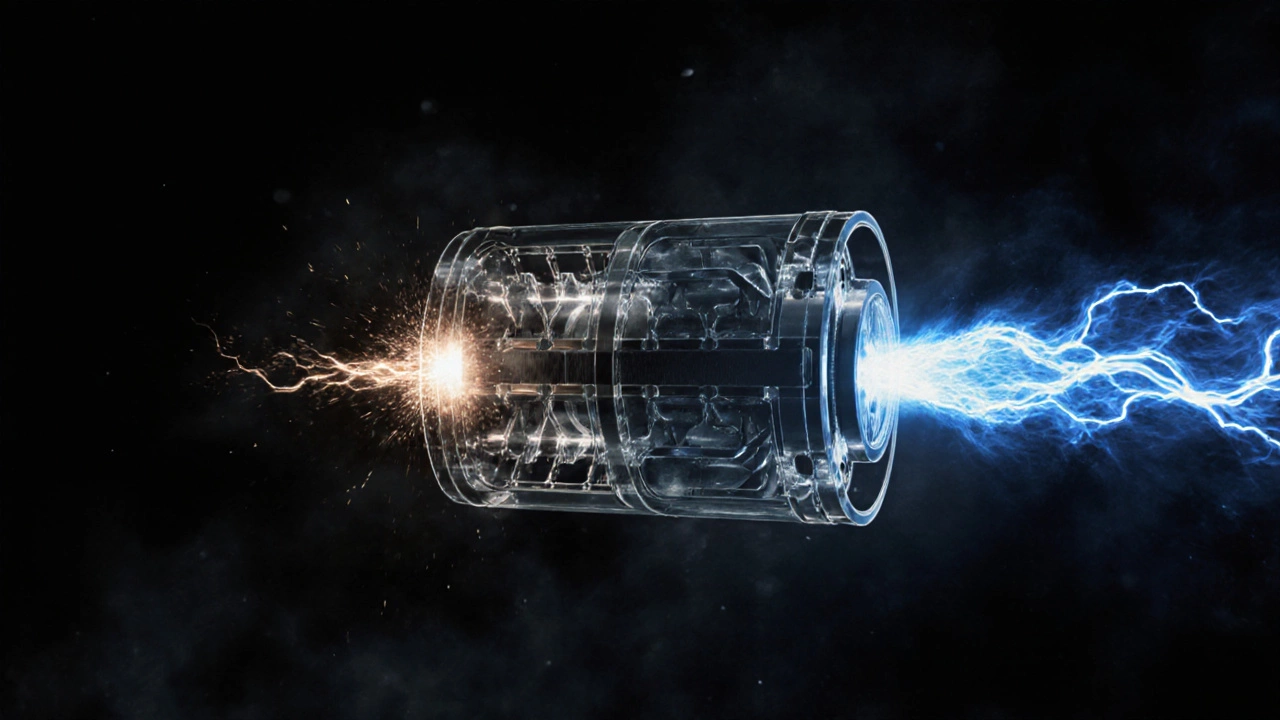Spark Plug Health Checker
Check if your spark plugs need replacement
Answer these questions based on your car's behavior. Note: This tool helps identify symptoms, not replace professional diagnosis.
Ever swapped out your spark plugs and wondered if it actually made any difference? You’re not alone. Many drivers replace them because the manual says so, or because a mechanic told them to-but then they drive off and feel… nothing. No sudden power boost. No miracle fuel savings. So what’s really going on?
What spark plugs actually do
Spark plugs are the ignition source in your engine. Every time your car fires up, a spark plug sends a tiny electrical pulse across a gap, igniting the fuel-air mixture in the cylinder. That’s it. Simple. But over time, that little gap wears out. Carbon builds up. The electrode erodes. The spark becomes weaker, slower, or inconsistent.
Most modern spark plugs last 60,000 to 100,000 miles, depending on the type. Copper plugs wear faster. Platinum and iridium last longer. But even the best ones don’t just stop working-they degrade slowly. And that’s the problem. The drop in performance is so gradual, your brain adjusts. You don’t notice the car is losing power because it’s been losing it over months.
What you might notice after replacement
If your plugs were badly worn, you’ll feel it. Not in a dramatic way, but in the small things:
- Smooth idle: No more rough shaking when you’re stopped at a light. The engine settles in like it used to.
- Better throttle response: When you press the gas, the car reacts faster. No hesitation. No lag.
- Quieter start: Cold starts become quicker and quieter. No more coughing or sputtering on a frosty morning.
- Improved fuel economy: A study by the Automotive Aftermarket Industry Association found that worn spark plugs can reduce fuel efficiency by up to 30%. After replacement, most drivers see a 4% to 8% improvement-enough to save £15 to £30 a year on fuel in the UK.
These aren’t flashy upgrades. They’re restorations. You’re not getting more power-you’re getting back what you lost.
When you won’t feel a difference
Here’s the truth: if your spark plugs were still in good shape, changing them won’t make your car feel faster. No magic. No turbo boost. Just a routine service that keeps things running as designed.
Some people swap plugs early-say, at 40,000 miles-thinking they’ll get a performance edge. They don’t. Modern engines are tuned to work with the plugs they came with. Unless you’ve got a performance upgrade or a misfiring engine, fresh plugs won’t make your car feel sportier.
And if you’re expecting a big jump in miles per gallon? Don’t. The biggest fuel gains come from fixing actual problems: clogged air filters, bad oxygen sensors, or dirty fuel injectors. Spark plugs? They’re part of the system-but not usually the main culprit.
Signs your spark plugs are actually bad
So how do you know if yours need replacing? Don’t just go by mileage. Look for these real-world signs:
- Check engine light with a misfire code (P0300-P0304)
- Hard starting, especially in cold weather
- Engine surging or stumbling during acceleration
- Increased fuel consumption without other obvious causes
- Rough idle that doesn’t go away after warming up
These aren’t subtle. If your car is acting up like this, it’s not a "maybe time to change them" situation. It’s a "do it now" situation.

What happens if you wait too long
Waiting isn’t just about missing out on performance. It’s risky.
Severely worn plugs can cause misfires that flood the catalytic converter with unburned fuel. That’s expensive. A damaged catalytic converter can cost over £1,000 to replace. That’s more than ten sets of spark plugs.
And if a plug breaks off in the cylinder head? You’re looking at a head removal and thread repair. That’s a £500+ job. And it’s not rare. In older cars with aluminum heads, over-tightening or corrosion can cause plugs to seize.
Replacing spark plugs isn’t about performance. It’s about avoiding disaster.
Real-world example: A 2015 Ford Focus in Bristol
A customer came in last spring with a 2015 Focus. Said it felt sluggish, used more fuel, and sometimes jerked when accelerating. Mileage? 98,000 miles. Original plugs. No warning lights.
We pulled the plugs. One was covered in thick, black carbon. Another had a cracked insulator. The gap on all of them was wider than it should’ve been-over 1.4mm instead of 0.8mm.
We replaced them with iridium plugs (NGK LFR7AIX). Three days later, the driver called back. "It’s like the car remembered how to drive." Idle was smoother. Acceleration felt crisper. And fuel economy jumped from 38 mpg to 42 mpg. Not because the new plugs were better-but because the old ones were failing.
Do you need to change them if you don’t feel anything?
Yes. But not because you’ll feel a difference.
You change spark plugs because they’re a scheduled maintenance item. Like oil changes or brake fluid flushes. They wear out. They’re cheap. And if you ignore them, you risk bigger, costlier problems.
Think of it like changing your toothbrush. You don’t do it because your teeth feel better right away. You do it because if you don’t, you’ll get cavities.
Most manufacturers recommend replacement every 60,000 to 100,000 miles. Stick to that. Don’t wait for symptoms. Don’t rely on how the car "feels."

What kind of spark plugs should you use?
Stick with what your car came with-or better. Don’t go cheaper. A £5 bargain plug might fit, but it won’t last. And it might not spark right.
Here’s what works:
- Original equipment (OE) spec: Best for daily drivers. Match the heat range and electrode material.
- Iridium: Longer life, better performance. Worth it for cars over 5 years old.
- Platinum: Good balance of cost and durability.
- Copper: Only for older cars or high-performance engines. Shorter lifespan.
Never mix brands or types unless you’re sure they’re compatible. Your engine was designed for a specific spark profile.
Final takeaway
Do you feel a difference after changing spark plugs? Sometimes. But not always.
If your plugs were worn out, you’ll notice smoother operation, better throttle response, and a bit more fuel efficiency. Not a revolution-but a return to normal.
If your plugs were still good? You won’t feel anything. And that’s fine. You did what you were supposed to do.
Spark plug replacement isn’t about upgrading your car. It’s about keeping it healthy. Like changing the air filter. Or topping up the coolant. It’s maintenance. Simple. Necessary. And cheap compared to what happens if you skip it.
Change them on time. Don’t wait for the car to beg for help.
Can bad spark plugs cause the check engine light to come on?
Yes. Worn or fouled spark plugs often cause misfires, which trigger the check engine light with codes like P0300 (random misfire) or P0301-P0304 (specific cylinder misfire). If the light is flashing, it means the misfire is severe and can damage the catalytic converter. Don’t ignore it.
How often should I replace spark plugs?
Most modern cars need new spark plugs every 60,000 to 100,000 miles. Copper plugs last 20,000-30,000 miles. Platinum plugs last 60,000-80,000 miles. Iridium plugs can go 100,000+ miles. Always check your owner’s manual. Don’t guess.
Can I change spark plugs myself?
Yes, if you have basic tools and some patience. You’ll need a spark plug socket, extension, torque wrench, and gap tool. Make sure the engine is cold. Remove the ignition coils or wires one at a time. Don’t cross-thread the new plugs. Tighten to the manufacturer’s torque spec-usually 15-20 Nm. Over-tightening can crack the plug or strip the threads.
Do expensive spark plugs improve performance?
Not in a normal car. Iridium and platinum plugs last longer and fire more consistently, but they won’t make your car faster unless the original plugs were failing. In a stock engine, the difference between a £10 plug and a £25 plug is lifespan, not power. Save your money unless you’re tuning the engine.
Can spark plugs affect emissions?
Absolutely. Worn spark plugs cause incomplete combustion, which increases hydrocarbon and carbon monoxide emissions. That’s why your car might fail an MOT if the plugs are bad-even if everything else is fine. Replacing them can help you pass.
Next steps if you’re unsure
If you’re not sure whether your spark plugs need replacing, here’s what to do:
- Check your owner’s manual for the recommended replacement interval.
- Look at your service history. When were they last changed?
- Use an OBD2 scanner to check for misfire codes.
- If you’re over 80,000 miles and haven’t changed them, plan to do it soon.
- If your car is acting up, don’t wait. Get it checked.
Spark plugs are one of the cheapest fixes with the biggest long-term payoffs. Do it right. Do it on time. And don’t expect magic-just expect your car to run like it should.






